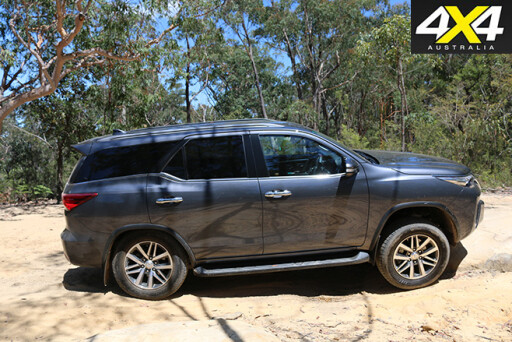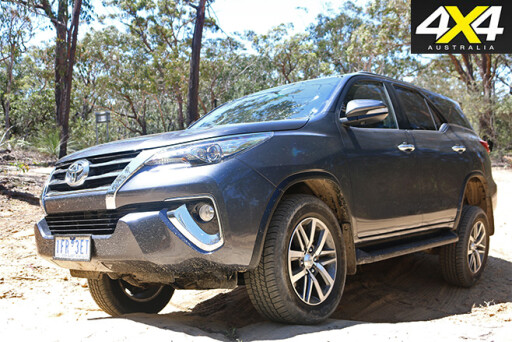
The Fortuner slots in below the Prado as the most affordable proper off-road diesel in the Toyota line-up.
WHAT’S THE DEAL?
Prices start at $47,990 for the entry-level GX, which gets cruise control, auto headlights, a reversing camera and seating for seven. The wheels are steel 17-inch units but, as with all models, it gets a rear diff lock.
As with all models, an auto transmission adds $2000.
From there it’s a step up to the GXL ($52,990), which adds alloy wheels, roof rails, smart key entry, tinted windows and an auto up/down function for all electric windows (the GX gets that functionality only on the driver’s window). There’s also an ‘intelligent manual transmission’, which includes a mode to match engine revs on gear changes. It’s particularly useful on downshifts where it gives a race driver-like blip of the throttle for seamless changes.
 Topping the range is a new nameplate in the Crusade ($59,990), which is the model we’ve tested here. It gets 18-inch alloys, sat-nav, digital radio, a powered tailgate, powered driver’s seat, some leather trim, fake wood trim and a 220V power point.
Topping the range is a new nameplate in the Crusade ($59,990), which is the model we’ve tested here. It gets 18-inch alloys, sat-nav, digital radio, a powered tailgate, powered driver’s seat, some leather trim, fake wood trim and a 220V power point.
PRACTICALITY
It’s slightly shorter (by 135mm), narrower (30mm) and lower (45mm) than a Prado and sits on a wheelbase that’s 40mm shorter. The length comparisons are skewed by the Prado’s tyre protruding on the swing-out tailgate, whereas the Fortuner’s tyre sits under the rear (meaning only one 80-litre fuel tank rather than the twin tanks that total 150 litres in the Prado).
Inside there’s not the sense of space – particularly head room – of a Prado. But there’s decent room to move and seating for seven. All three rows get fresh air courtesy of vents in the roof.
The centre seatbelt in the middle row comes out of the roof, and the seats themselves flip and slide in a 60/40 configuration.
 The third row folds against the size similar to the previous generation 120-Series Prado and the current 200 Series Land Cruiser. It means they take up a fair bit of space, although they can be bolted out for those never planning to use them.
The third row folds against the size similar to the previous generation 120-Series Prado and the current 200 Series Land Cruiser. It means they take up a fair bit of space, although they can be bolted out for those never planning to use them.
With those seats folded up to the side, the boot space goes from generous to average.
Still, there’s respectable storage elsewhere – door pockets and a cooled centre console, for example – and a decent layout to the main controls up front.
ON THE ROAD
The Fortuner is largely Hilux underneath but with a slightly shorter wheelbase and coil spring rear-end. No surprises then that’s it’s got that rugged, utilitarian feel to it. With one or two on board, it’s reactive to city bumps and prone to some rocking and rolling through bends.
But it deals well with chunky dirt roads and lumpy tracks.
The 2.8-litre four-cylinder turbo-diesel – the same one used in the Hilux and Prado – is honest but uninspiring. The 130kW of power is largely academic because it’s the 450Nm you’ll be using most. It’s not as quiet as it is in the recently updated Prado, but it feels more lively because the Fortuner is a few hundred kilos lighter (from 2110kg, for the GX, to 2135kg, for the Crusade).
 Like all Toyota off-roaders the steering has vagueness, but it’s faithful in its responses.
Like all Toyota off-roaders the steering has vagueness, but it’s faithful in its responses.
OFF-ROAD
Key to the Fortuner’s ability is its towering 279mm of ground clearance. It also gets the Hilux’s full artillery of steel protection for mechanical vitals underneath.
It sets the scene for what is a very capable off-roader.
The four-wheel drive system is part-time, so with torque going to all four wheels it can’t be driven on bitumen. But off-road it combines with the locking rear differential for excellent traction.
 Wheel articulation is also decent ensuring you have to really cross it up before wheels start hanging in the air.
Wheel articulation is also decent ensuring you have to really cross it up before wheels start hanging in the air.
Unlike some Toyotas – and the recently released Ford Everest – there’s no terrain select system to adjust throttle and transmission sensitivity (and tailor the traction control). Such a system would be handy in low speed rock crawling, where the relatively sensitive throttle (in low range) means being gentle with the right foot.
The 30-degree approach angle is also great, with the steel underbody protection generally the first thing to come in contact with something at the front. At the rear the spare tyre partly protects the bumper, but we found it was the mud flaps that were the first things to scrape.
 The Fortuner is claimed to tow up to 3000kg, but that’s only for the manual, which gets slightly less torque than the auto (420Nm versus 450Nm). The auto still outdoes the Prado, though with a 2800kg capacity.
The Fortuner is claimed to tow up to 3000kg, but that’s only for the manual, which gets slightly less torque than the auto (420Nm versus 450Nm). The auto still outdoes the Prado, though with a 2800kg capacity.
While the Fortuner’s 80-litre fuel tank is on par with key ute-based SUV rivals – Isuzu MU-X, Holden Colorado7, Mitsubishi Pajero Sport and Everest – it’s almost half the size of the Prado’s, limiting the realistic range to about 600km.
As with other Toyotas, there’s an extensive range of accessories, including bullbars, roof racks, a snorkel and an integrated Warn Winch. There’s also a separate fuse box under the bonnet to make it easier to wire extra gear.
VERDICT
It’s simple, honest and impressively effective off-road. The Fortuner doesn’t set any new standards. But it does offer a rugged and capable alternative to the Prado for those who don’t needs its slightly larger dimensions.
 There are notable compromises, but the core engineering ensures it’s a 4x4 you’ll likely see more of in the bush. One of the early challenges could be getting hold of one; Toyota is supply-constrained on Fortuner throughout 2016.
There are notable compromises, but the core engineering ensures it’s a 4x4 you’ll likely see more of in the bush. One of the early challenges could be getting hold of one; Toyota is supply-constrained on Fortuner throughout 2016.
Price and specifications
Price: $59,990
Engine: 2.8-litre 4-cylinder turbo diesel, 130kW at 3400rpm, 450Nm at 1600-2400rpm
Transmission and 4WD system: 6-speed auto, part time dual-range 4WD
Braked tow capacity: 2800kg
Spare tyre: Full size
Fuel tank: 80 litres
Fuel use (claimed): 8.6L/100km
Fuel use on test: 11.5L/100km
Approach/departure angles: 30 degrees/25 degrees
Ground clearance: 279mm

COMMENTS